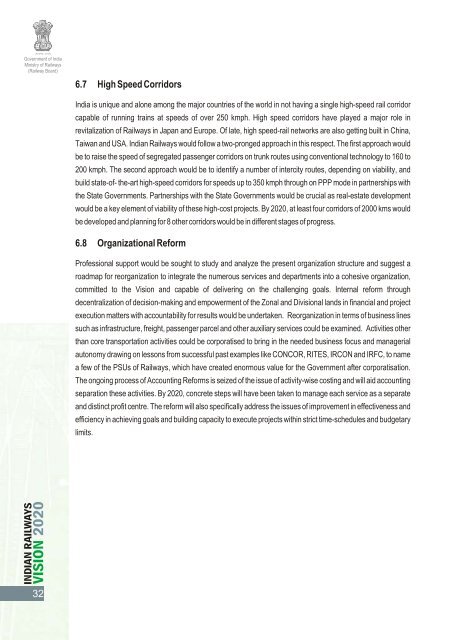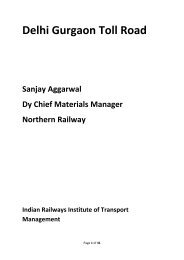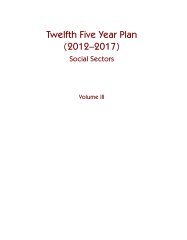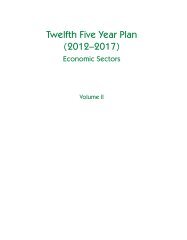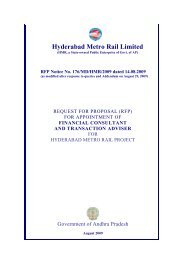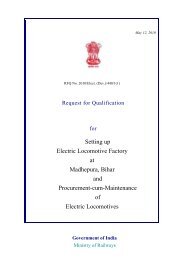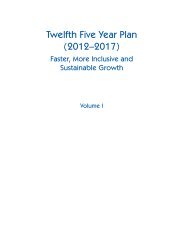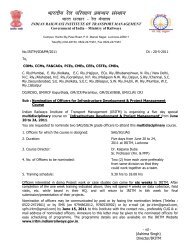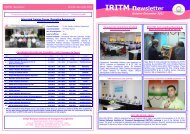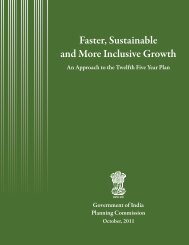Vision 2020 - Transportation Research Group of India
Vision 2020 - Transportation Research Group of India
Vision 2020 - Transportation Research Group of India
Create successful ePaper yourself
Turn your PDF publications into a flip-book with our unique Google optimized e-Paper software.
Government <strong>of</strong> <strong>India</strong><br />
Ministry <strong>of</strong> Railways<br />
(Railway Board)<br />
6.7 High Speed Corridors<br />
<strong>India</strong> is unique and alone among the major countries <strong>of</strong> the world in not having a single high-speed rail corridor<br />
capable <strong>of</strong> running trains at speeds <strong>of</strong> over 250 kmph. High speed corridors have played a major role in<br />
revitalization <strong>of</strong> Railways in Japan and Europe. Of late, high speed-rail networks are also getting built in China,<br />
Taiwan and USA. <strong>India</strong>n Railways would follow a two-pronged approach in this respect. The first approach would<br />
be to raise the speed <strong>of</strong> segregated passenger corridors on trunk routes using conventional technology to 160 to<br />
200 kmph. The second approach would be to identify a number <strong>of</strong> intercity routes, depending on viability, and<br />
build state-<strong>of</strong>- the-art high-speed corridors for speeds up to 350 kmph through on PPP mode in partnerships with<br />
the State Governments. Partnerships with the State Governments would be crucial as real-estate development<br />
would be a key element <strong>of</strong> viability <strong>of</strong> these high-cost projects. By <strong>2020</strong>, at least four corridors <strong>of</strong> 2000 kms would<br />
be developed and planning for 8 other corridors would be in different stages <strong>of</strong> progress.<br />
6.8 Organizational Reform<br />
Pr<strong>of</strong>essional support would be sought to study and analyze the present organization structure and suggest a<br />
roadmap for reorganization to integrate the numerous services and departments into a cohesive organization,<br />
committed to the <strong>Vision</strong> and capable <strong>of</strong> delivering on the challenging goals. Internal reform through<br />
decentralization <strong>of</strong> decision-making and empowerment <strong>of</strong> the Zonal and Divisional lands in financial and project<br />
execution matters with accountability for results would be undertaken. Reorganization in terms <strong>of</strong> business lines<br />
such as infrastructure, freight, passenger parcel and other auxiliary services could be examined. Activities other<br />
than core transportation activities could be corporatised to bring in the needed business focus and managerial<br />
autonomy drawing on lessons from successful past examples like CONCOR, RITES, IRCON and IRFC, to name<br />
a few <strong>of</strong> the PSUs <strong>of</strong> Railways, which have created enormous value for the Government after corporatisation.<br />
The ongoing process <strong>of</strong> Accounting Reforms is seized <strong>of</strong> the issue <strong>of</strong> activity-wise costing and will aid accounting<br />
separation these activities. By <strong>2020</strong>, concrete steps will have been taken to manage each service as a separate<br />
and distinct pr<strong>of</strong>it centre. The reform will also specifically address the issues <strong>of</strong> improvement in effectiveness and<br />
efficiency in achieving goals and building capacity to execute projects within strict time-schedules and budgetary<br />
limits.<br />
32


